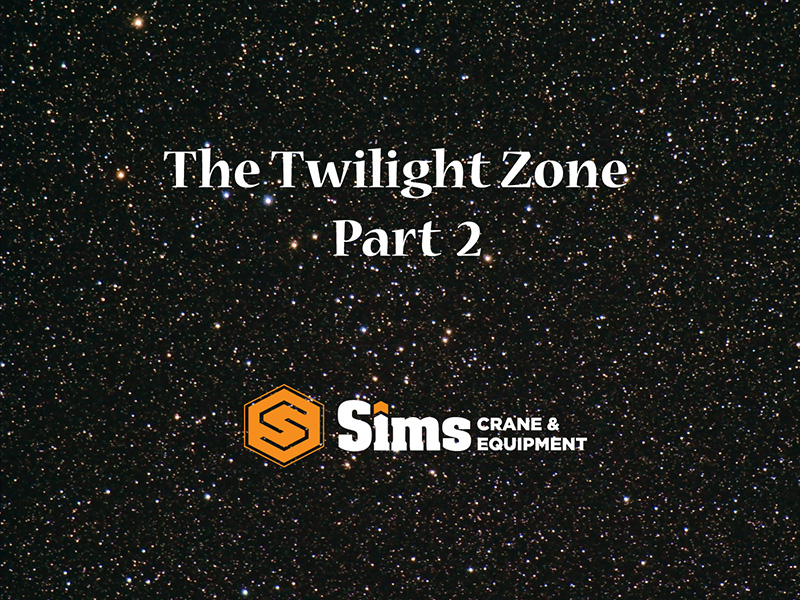
Sims Crane brings you a series written by Ron Kohner, President, Landmark Engineering Services Ltd., in which he explains the meaning and implications of the "bold line" present in the crane manufacturers' lift charts.
With a wink and a nod, many crane users and operators over the years have patiently lectured that it is “sort of okay” to lift loads heavier than shown on a crane’s load rating chart if the associated bold line, shading or asterisks on the chart indicate that stability is the limiting factor for the particular crane configuration.
Having spent 17 years as an engineer responsible for producing load rating charts for a major crane manufacturer, I have felt obligated to try to explain to anyone willing to listen why this is not true. Several years ago I wrote an article titled “Operating in the Twilight Zone of crane capacities.”
Industry Standards
Today, many crane owning companies may still be operating in the twilight zone, so to speak, between the weight of a load required to bring a crane to an actual tipping condition and the capacity value shown on the load rating chart. I use the example of an imaginary crawler mounted crane which would tip if attempting to lift a 100,000-pound load at a 20 foot radius. Industry standards mandate that such a crane cannot be rated higher than 75,000 pounds (75 percent of the tipping load) at that radius. While the load rating chart indicates the 75,000-pound value is limited by stability, the crane would not actually begin to show signs of getting light (i.e. tipping) until near 100,000 pounds. The critical factor here is that once the 75,000-pound value is exceeded, you are entering the twilight zone, and the crane is being overloaded.
Before 100,000 pounds is reached, the boom, the swing bearing, the hydraulic or pneumatic systems, the brake and clutch mechanisms and related systems on the crane may be overloaded or damaged and possibly even failing before signs of tipping are detected. No one but the crane manufacturer can determine precisely what limits are being exceeded in the twilight zone.
In the past, I focused on the twilight zone that exists for ratings shown to be limited by stability on the load rating chart. A closely related issue is that industry jargon typically refers to ratings not limited by stability as “structurally limited” ratings. This terminology likely derives from wording in the initial 1968 version of USAS B30.5 regulations which refer to ratings “limited by structural competence.”
Terminology Changes
Ever since 1982 however, B30.5 has changed its terminology to “limited by structural, hydraulic or other factors rather than stability.” The key term “other factors” acknowledges the reality that a multitude of limitations exist other than those based on structural integrity. Unfortunately, in most conversations, it is simply easier to refer to either “stability ratings” or “structural ratings”. In the past, I have been as guilty as anyone of such mis-speak.
This distinction becomes more critical if assumptions are made concerning precisely what information can legitimately be drawn from a load rating chart’s current stability/non-stability format.
These are but a few of the “other factors” which can limit what are generically (an often incorrectly) viewed as “structural” limits. Since the limits are so diverse in nature, no one outside the crane manufacturer’s engineering personnel can predict where on the load rating chart a particular limiting condition comes into play. Not even the manufacturer’s engineers can identify rating limits without researching the origins of the values published on a chart or displayed on an LMI readout. While unsubstantiated user assumptions concerning the patterns of “structural” limits for crane load ratings generally focus on those ratings which are shaded, asterisked or above the bold line, misunderstandings also carry over to the twilight zone related to stability limited ratings.
When working strictly within areas of the load rating chart shown to be limited by stability, the limiting criteria on which those chart values are based derive solely from the assumption that the crane is lifting only in the direction in which it is least stable. This is commonly over the side of a carrier or crawlers, (i.e. perpendicular to the longitudinal centerline of the lowerworks). Swinging even a few degrees away from this least stable direction, the crane rapidly becomes more stable and the chart values no longer relate to the ultimate loads required to tip the crane in the direction of lifting. The farther one swings away from the least stable direction, the less chart values are accurately predictive of a crane’s actual tipping characteristics and the farther one can slip into the twilight zone where crane components are being overloaded, often without any observable indication of distress.
Misinformation Persists
In view of these facts, it is not surprising to note that an executive in the crane operator testing industry recently observed: “The data is pretty clear on this – there is no more abused, misunderstood or just plain ignored aspect of crane operations than the crane’s load chart.” This observation clearly indicates that issues of misinformation persist within the lifting industry. How many times have we heard: “Never exceed the chart.” While this may be viewed as trite and preaching to the choir, good practice demands that users not try to second guess the crane manufacturer concerning equipment limitations which they believe can somehow be telepathically extracted from rating chart patterns to provide a capacity advantage. Don’t listen to the little voice that you imagine is revealing secrets about the “other factors” hidden within the shading, asterisks or bold lines that appear on most load rating charts. Always stay out of the twilight zone of the chart and everyone’s safety will be better served.
For ten factors manufacturers must consider as possible limitations when determining the crane's lift chart ratings click here.
Source: American Crane & Transport, June 2013 Issue